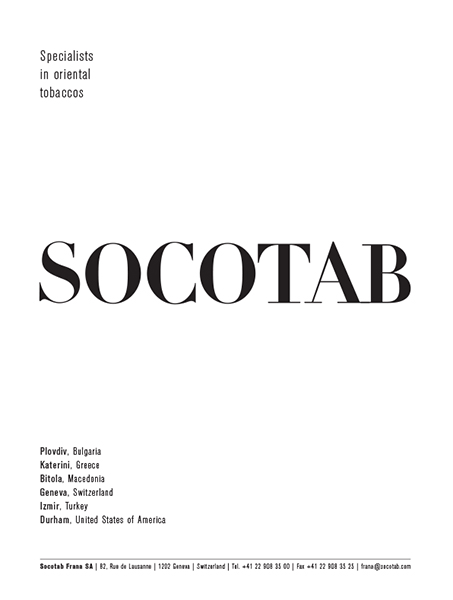
Reynolds’ James Murphy discusses the challenges and
opportunities for tobacco harm reduction.
By Stefanie Rossel
In September 2020, James Murphy took over as executive vice president of research and development at Reynolds American Inc. (RAI), a subsidiary of British American Tobacco and the second-largest tobacco company in the U.S. Tobacco Reporter caught up with Murphy to discuss the challenges and opportunities he faces in his position.
Tobacco Reporter: Upon assuming your position, you conducted a poll among 2,000 U.S. consumers. What were the main findings, and what do you make of them?
James Murphy: We did a poll of 21-plus adults to examine issues related to tobacco harm reduction [THR] because it is an incredibly important priority for us. The results were consistent with other published research; there is confusion about whether innovative products—such as e-cigarettes—present less risk, and in particular, the role of nicotine as a cause of harm.
A similarly large proportion misunderstand nicotine as a cause of smoking-related diseases. Many adult smokers simply do not know that the toxicants generated from tobacco combustion—rather than nicotine or tobacco itself—is the leading cause of smoking-related health harm. Lack of information creates steep barriers for adult smokers to consider a switch to smoke-free tobacco and nicotine alternatives that are potentially less harmful to their health.
Misunderstandings about innovative alternative products, and nicotine itself, are a hurdle toward shared progress. The good news is that reducing harm from combustible tobacco products was considered an important public health priority by more than two-thirds—70 percent—of the adults we surveyed. Thus, there is strong public recognition of the need for innovative solutions to the harms caused by smoking.
This data underscores our commitment and focus on building productive working relationships with legislators and regulators around the country in pursuit of our common goal: reducing smoking rates, keeping tobacco products away from teenagers and ultimately reducing the harm from smoking in America.

Amid all restrictions on tobacco industry communications, what can the sector do to change consumers’ misperceptions on these issues and encourage smokers’ movement to less hazardous products?
This is a significant issue, and we are engaging with policymakers and legislators—many of whom share such misunderstandings—and the larger scientific and regulatory community. Misunderstanding of nicotine impairs harm reduction, and it must be addressed. As is well studied and understood, the toxicants from the combustion of tobacco drive smoking-related morbidity and mortality.
Yet behavioral research confirms consumer confusion on this point, and recent population-level data published by the Society for Research on Nicotine and Tobacco (SRNT) highlight that up to 80 percent of U.S. adults incorrectly believe that nicotine is responsible for most of the cancer caused by smoking.
Similarly, misunderstanding vapor and vapor flavors can lead to detrimental policies banning products, flavors and even categories of products, whose removal from market could create the unintended consequence of indirectly pushing adults and minors toward cigarettes. We saw this recently in the Yale School of Public Health study regarding San Francisco’s ban on flavored products, where the author found that it was associated with a significant increase in youth smoking there but not in other jurisdictions without the ban.
Regulatory policy should be based on the relative risks of tobacco products. We are committed advocates for a legislative and regulatory framework that recognizes the continuum of risk and includes risk-proportionate policies on taxation, public use and flavors and other aspects of the product that are important to encouraging adult smokers unwilling to quit to switch from cigarettes. Where regulation is based on scientific evidence and not opinion, public policy will benefit public health and contribute to better understandings of these important products.

During your recent presentation at the GTNF In Focus event, you hinted at the challenge of assessing the risk profiles of other next-generation products, such as modern oral nicotine, for which no epidemiological data are available yet. Can you elaborate?
The FDA is carefully vetting these products, and I have every confidence that their assessment is science-driven and made against the rigorous statutory standard of “appropriate for the protection of public health.” For newer products, such as THP and modern oral nicotine pouches, like vapor with less than a decade on the market, epidemiological data is still in progress.
In the absence of epidemiology, we use a weight-of-evidence approach comprised of laboratory, clinical and real-world population level studies. In our studies, we include both smokers and smokers who quit smoking as epidemiological gateposts and compare clinical and population outcomes for smokers who switch to the next-generation products (NGPs) against these two smoker statuses.
Consider snus usage in Sweden as a strong illustration of THR in action. Smokers have switched to using snus over several decades, and the country now has the lowest lung cancer rates in the whole of the EU. This epidemiological data is the cornerstone of substantiating the beneficial population health impacts of products like snus in countries like Sweden but also within the USA.
In studies we have conducted and published to date, we have demonstrated that users switching to NGPs have similar biological outcomes to smokers who quit. As quitting has known favorable epidemiological outcomes, we can bridge the switch to NGP to quitting and conclude that both will have similar epidemiological outcomes, which would benefit population health in the long run.
The FDA has announced plans to ban menthol as a characterizing flavor in combustible cigarettes and has suggested that the agency may also reduce the nicotine content in cigarettes. Do you consider such measures as a sufficient incentive for smokers to switch to less harmful alternatives? What else needs to be done?
My concern is that any risk-based product standards on cigarettes will lead to confusion in the marketplace. For example, if a menthol product standard is introduced, smokers might wrongly perceive nonmenthol cigarettes as less risky. We know already that the general population misperceives the risks of nicotine when administered in a combustible product versus a noncombustible product and that there are misperceptions regarding the relative risks of vaping compared to smoking. THR presents a better way of reducing the harms from combustible tobacco use. Today in the U.S., millions of smokers have switched to products like vapor or nicotine pouch products. I have spent my career focused on THR and believe we must enable the introduction of satisfying, reduced harm alternatives that will facilitate the switching of smokers down the risk continuum while at the same time ensuring that adequate safeguards are in place against youth usage.
The FDA has recently spoke of finding this “sweet spot,” and ideally, all stakeholders in the THR debate will collaborate to make that happen.

What are your current research priorities?
Topline, we’re focused on reducing the health impact of our business based on scientifically substantiated reduced-risk products. These products will improve public health and ensure we have a sustainable future. That means establishing and supporting the weight of scientific evidence that appropriately stewarded noncombustion tobacco and nicotine products manufactured to high-quality standards have a role in THR.
In the U.S., we believe that the FDA will play a key role with their stewardship of the PMTA process to ensure that products which are appropriate for the protection of public health remain on market. This regulatory verification will improve smokers’ confidence in these products and facilitate the mass migration of smokers down the risk continuum. There is a large and growing body of evidence—including from Reynolds’ scientists—to support the reduced-risk potential of these categories.
We take two approaches for assessing the risk profile of noncombustible products: if a product has robust epidemiological data, then that data is used as a basis for risk assessment, but for newer products, in the absence of epidemiology—such as THP, vapor and modern oral products—we use a three-stage assessment of emissions, exposure and risk.
Judging from the results of your poll and from recent FDA moves, such as the proposed ban on menthol and planned maximum, nonaddictive nicotine levels in combustible cigarettes, which direction is THR taking in the U.S.?
We believe our broad portfolio of alternatives to combustible cigarettes can accelerate the population-level health benefits supported by the Family Smoking Prevention and Tobacco Control Act and envisioned by the FDA in its consistent endorsement of a comprehensive nicotine regulatory framework.
Potentially less harmful products must be able to compete effectively with the most harmful products, thus moving smokers down the risk continuum of nicotine products. Vaping bans and high taxes on alternatives that may present less risk than cigarettes will not help us reduce the harm from cigarette smoking.

What are the gaps in THR science from your point of view?
The biggest gap in THR science is caused by an ongoing boycott by various scientific conferences to publicize and share the latest THR research. The recent news from SRNT banning the tobacco industry from future conferences is particularly disappointing. The largest U.S. scientific conference on nicotine and tobacco research banning industry scientists seems counterintuitive. Moreover, the learning process is not merely what we share, but what we can learn from others. Personally, some of the most valuable professional insights I have received were from other U.S.-based academics commenting on our research during SRNT poster sessions.
Science—particularly science that underpins such important public health goals—deserves to be debated on its merits, particularly when the science on those same products is under scientific review by the FDA.
There is room for more consistent methodologies to ensure the consistent assessment of products as there is sometimes conflicting data published on both sides of the THR debate. There is also a gap in evidence for assessing THR products in that we do not have epidemiological data for newer products like THP, vapor [and] modern oral, which have only been on market for five [years] to ten years. That data gap points to a need for agreed proxies to assess individual risk reduction, such as biomarkers of potential harm and quality-of-life measurements, and other real-world evidence which may play a role.












